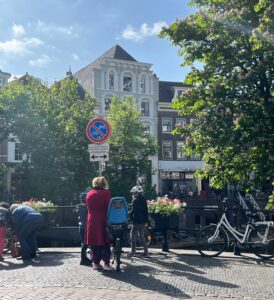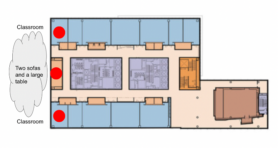[urban interfaces] Blogs
Guest blogpost: Yu Sang – Beyond Sight: Navigating Urban Through Listening
For our [urban interfaces] seminar series on the theme Creative Urban Methods (year 2022-2023), we invited participants to write blogposts. The best and most interesting ones we publish on our website.
Below is the blogpost for seminar session #3, written by Yu Sang:
Yu Sang is currently a research Master’s student in Media Studies at the University of Amsterdam, with a specialization in Television and Cross-Media Culture. Her research interests are in the intersection of environmental media, infrastructure studies, and urban studies. Prior to pursuing her Master’s degree, Yu completed a Bachelor of Science in Interactive Media Art at New York University, where she was involved in several research projects related to urban design and public art.
Beyond Sight: Navigating Urban Through Listening
By Yu Sang

Listening as Practice
In the final session of the seminar on Creative Urban Methods from [Urban Interfaces], we collaboratively explored the concept of deep listening as a creative research method to study urban space. Nahuel Cano, an actor and sound artist, shared his experiences with sounds during his performances and artistic creations. He carefully described the nuances of silence, delay, and change within the film set, interpreting them as vital components that arise from the interaction between sounds, environment, and human bodies. For Cano, the soundscape is not just a background; it becomes a transformative medium for artistic engagement. He does not perceive listening as a mere passive act; instead, it is a conduit for him to interact with and be shaped by the world.
Cano’s perspective on listening draws considerable inspiration from Salome Voegelin’s philosophy of sound. In Voegelin’s book, Listening to Noise and Silence: Toward a Philosophy of Sound Art: Towards a Philosophy of Sound Art(2010), she elaborates on the concept of intersubjectivity, positing it as a vital role in listening practice. Unlike a viewer, who maintains a discernible distance from what they observe, a listener’s position is always “entwined with the heard” (Voegelin 2010, 5). This intimate proximity collapses the space between the subject and the object, fostering a unique intersubjectivity in the act of listening. Then, what insights can we glean from an immersive listening practice? How does deep listening reshape our understanding of the surrounding space? With these questions in mind, we experimented with deep listening as a way of sensing and making sense of the environment in the following part of the session.
Exercise 1: Listen to the Surrounding
We stood near the room’s entrance with our eyes closed. As someone with aphantasia, closing my eyes meant a complete detachment from visual information and the inability to summon mental imagery. I experienced a moment of anxiety and then, a mix of sounds – the subtle electronic buzz, creaks emanating from the room’s aged furniture, distant church bells, and footsteps that echoed the city’s life – all intermingling with my own rhythmic breathing. I could not precisely pinpoint the sources but merely received them. My attempt to distinguish and relate them to familiar auditory memories invoked an unsettling anxiety, reminiscent of sleepless nights when even faint sounds, like a distant car’s hum, became amplified. During this process, the delineation between the internal and external, self and the outer world, past and present blurred, and each sound coalesced into my unified auditory experience.
Deep listening, as Pauline Oliveros defines in her book Deep Listening: A Composer’s Sound Practice, is “a practice that is intended to heighten and expand the consciousness of sound in as many dimensions of awareness and attentional dynamics as humanly possible” (2005, 23). This practice requires us to engage deeply with our sonic environment, attuning to the various layers and textures of sounds. When our group reopened our eyes and shared our experiences, there was much discussion about the direction, evolution, spatiality, and temporality of sounds. However, what interested me most were the personal narratives that these sounds evoked. Many among us found a deep connection between the sounds of the present and our own life stories and emotions., affirming that our experiences and memories dynamically shape and are shaped by the surrounding sounds. According to Oliveros, deep listening extends beyond merely tuning in to external sounds; it also involves “noticing my listening or listening to my listening and discerning the effects on my body mind continuum, from listening to others, to art and to life” (2005, 24).
Exercise 2: Listening to Utrecht
For the second listening exercise, we were instructed to walk through the urban space and map the urban soundscape together. Having only visited Utrecht two previous times, both for seminars, I was unfamiliar with its urban environment. This practice offered me an opportunity to get to know a new city from an acoustic perspective. Raised in China and now residing in Amsterdam, the distinctions between Chinese cities and Dutch ones like Utrecht were evident. Nevertheless, listening still unveiled nuances of understanding, which subtly differs from viewing-based knowledge. For instance, while I cognitively knew bicycles dominated Dutch transport, the act of deep listening transformed this piece of information from mere epistemic knowledge into an embodied experience. I not only heard but also felt the sounds of bicycles varying in weight and material, and the vibration they produced during their interaction with the ground. The absence of cars contributes to the tranquility of Utrecht, and the omnipresence of bicycle sounds defines its unique soundscape. For the study of urban aesthetics and atmosphere, visual analysis has dominated for a long time. I think listening should also be considered as a fundamental research methodology. As a way of knowing, listening produces generative, contingent, fleeting, and partial knowledge and can also capture the ever-evolving lived experience that constitutes our urban life.
An intriguing facet of this exercise stemmed from my unfamiliarity with the Dutch. Since I did not understand Dutch at all, I quickly disregarded attempts to comprehend passing conversations. This allowed me to easily perceive humans, including me, in a relatively equal way to other urban sound sources, such as birds, dogs, bicycles, and bells. The clatter of bicycles drew my attention and also startled the pigeons. The swift flights of pigeons quelled human dialogues and generated the soft rustle of descending leaves. This aural tapestry highlighted the intricate interplay between humans and nature, revealing how we influence and interpret each other. Deep listening has the potential to trace this relationality and to practice Eduardo Kohn’s proposal of radically rethinking the representation system that extends “beyond human minds and human systems of meaning” (2013, 31).
Auditory Boundaries: Rethinking Urban Designs
Two deep listening exercises uncovered the intricate layers of sounds that form the urban soundscape and influence our experiential interactions. I posit that listening is not just about recognizing these layers; it can also be a method to navigate, or even challenge the prevailing spatial designs that are predominantly influenced by vision. The orders established in the visual sphere sometimes become debatable when assessed acoustically. Which sounds are internal, and which are external? Then, how do we demarcate private from public spaces? Whose responsibility is it to manage specific sounds, and within which boundaries? Furthermore, how might design be harnessed to mitigate sound-induced conflicts?
In my small course project in undergraduate study, I experimented with drawing acoustic boundaries on campus. I found that the administrative design of the campus space follows more of a visual logic while neglecting the acoustic dimension. One typical example is the arrangement of classrooms and community space. Perhaps to match the huge floor-to-ceiling windows, two large sofas and a large table were placed at the end of the hallway, creating a lively hub for relaxation, dialogue, and group meetings—all generating considerable noise. Adjacent classrooms, though visually insulated by doors, were acoustically permeable. Even worse, these two classrooms were most used due to their medium size. With sound bleeding freely between these zones, clashes between different users became inevitable. It was not uncommon for professors to request a lower voice outside while students found themselves compelled to speak loudly due to the designed function of the space.

While this might be a small indoor scenario, parallel conflicts – between residents and the broader public over noise disputes – are rampant in larger urban landscapes. Deep listening stands as a potent tool, not only in detecting and understanding these transient conflicts but perhaps even in preempting them, aiding in the proactive redesign of spaces. As noted by Sabina Andron (2016), urban space is full of territorial and ownership controversy marked by visual signs. In many cases, sounds also actively participate in these dynamics and deserve more attention.
Bibliography
Andron, Sabina. 2016. “Interviewing Walls: Towards a Method of Reading Hybrid Surface Inscriptions.” In Graffiti and Street Art, edited by Konstantinos Avramidis and Myrto Tsilimpounidi, 1st ed., 71–88. Routledge.
Kohn, Eduardo. 2013. How Forests Think: Toward an Anthropology beyond the Human. Berkeley: University of California Press.
Oliveros, Pauline. 2005. Deep Listening: A Composer’s Sound Practice. New York, NY: iUniverse.
Voegelin, Salomé. 2010. Listening to Noise and Silence: Towards a Philosophy of Sound Art. New York: Continuum.

